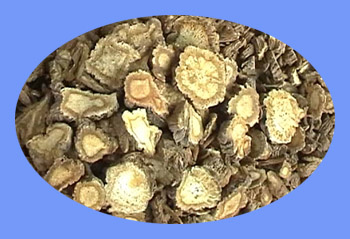
Chinese
Angelica Root (dang gui)
Radix
Angelicae Sinensis
Properties:
Pungent and sweet in flavour, warm in nature, it is
tropistic to the heart, liver and spleen channels. Being
sweet, warm and moist in property, this herb serves
function of replenishing blood; and being pungent, warm
and volatile in nature, it also can promote blood
circulation, as a main herb for enriching blood and
promoting the circulation of blood regulate menstruation
and relieve pain. It is often used to treat any syndromes
of blood-deficiency, various kinds of pain due to blood
stasis, menoxenia, sores, ulcers, ulcers, swellings and
traumatic ecchymoma, etc. It also functions in nourishing
blood and lubricating the bowel, serving for constipation
due to blood deficiency and dryness in the bowel.
Effects:
Tonifying blood, promoting blood circulation, regulating
menstruation, alleviating pain, and lubricating the bowels
to relieve constipation.
Indications:
1. For any
syndromes of blood deficiency, it is often used with Radix
Rehmanniae Praeparata, Radix Paeoniae Alba and Rhizome
Ligustici Chuanxiong to nourish the blood, as in Decoction
of Four Ingredients (Siwu Tang)
.2. For menoxenia,
menorrhalyia and amenorrhea in the type of blood
deficiency, it is used together with Radix Rehmanniae
Praeparata, Radix Polygoni Multiflori, Radix Paeoniae
Alba, Caulis Spatholobi, etc. to replenish blood and
regulate menstruation; for those in the type of blood
stasis, it is used with herbs for promoting blood
circulation and for regulation menstruation, such as
Rhizoma Ligustici Chuanxiong, Semen Persicae, Flos
Carthami, etc. ; and for those in the type of
deficiency-cold, it is used with herbs for warming
channels and dispelling cold pathogen, such as Folium
Artemisiae Argyi, Ramulus Cinnamomi, Fructus Euodiae, etc.
3. For chest and
abdominal pain due to blood stasis, it is often used with
herbs for resolving blood stasis to relieve pain, such as
Resina Olibani, Myrrha, Radix Salviae Miltiorrhizae; for
obstruction of the heart channel manifested as oppressive
pain in the chest, it can be used Flos Carthami, Radix
Salviae Miltiorrhiz, Rhizoma Ligustici Chuanxiong, Lignum
Dalbergiae Odoriferae, etc.
4. For traumatic
ecchymoma and pain, and for sores, carbuncles and
swelling, it is often used with herbs for promoting blood
circulation and tissue regeneration and relieving pain,
such as Resina Olibani, Myrrha. Squama Manitis, etc.
Besides, it is
also used with Radix Paeoniae Alba, Fructus Cannabis, etc.
to treat constipation due to blood deficiency and dryness
in the bowel.
Dosage and
Administration:
6-12g.
----------------------------------------------------------------------------------------------

For the
convenience of customers, we offer the
Chinese
Angelica Root (dang gui)
as
the quick-dissolving granule made through modern
technology.
Directions:
Every
sachet is equivalent to raw herb 10 grams.
The dosage is for
adults, one sachet each time, twice a day. Please
put the granule into a cup, then put 50-100ml
boiling water into the cup and stir it with spoon.
You will get some tea, drink it when it is luke-warm.
For children, the dosage should be reduced according
to the weight.
Air ship 50 sachets of
Chinese
Angelica Root (dang gui)
in the form of quick-dissolving granule for your
personal use now at $98.00.
If you would like to
order this raw herb, please go to
the order form.